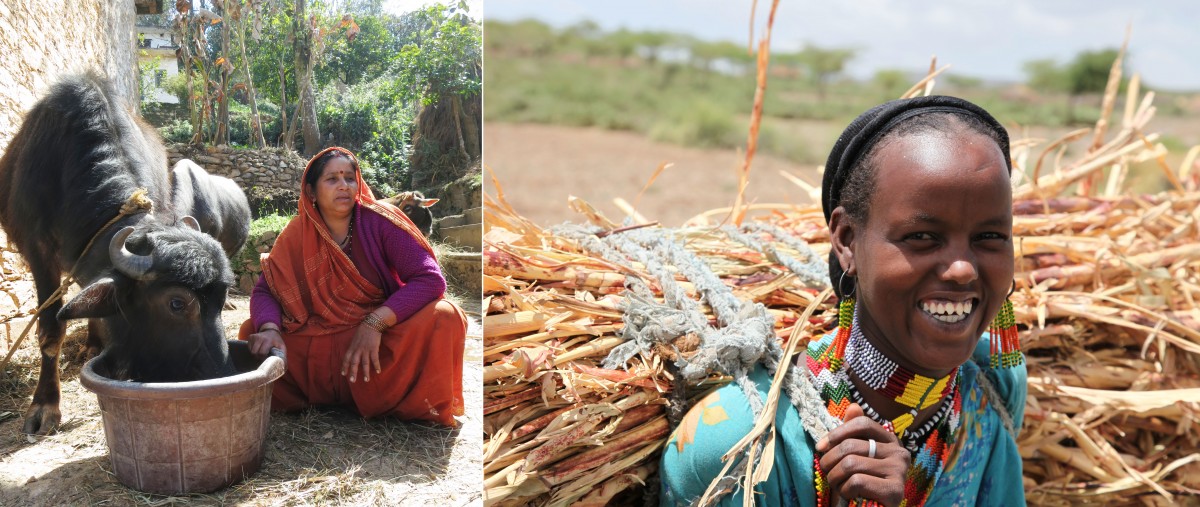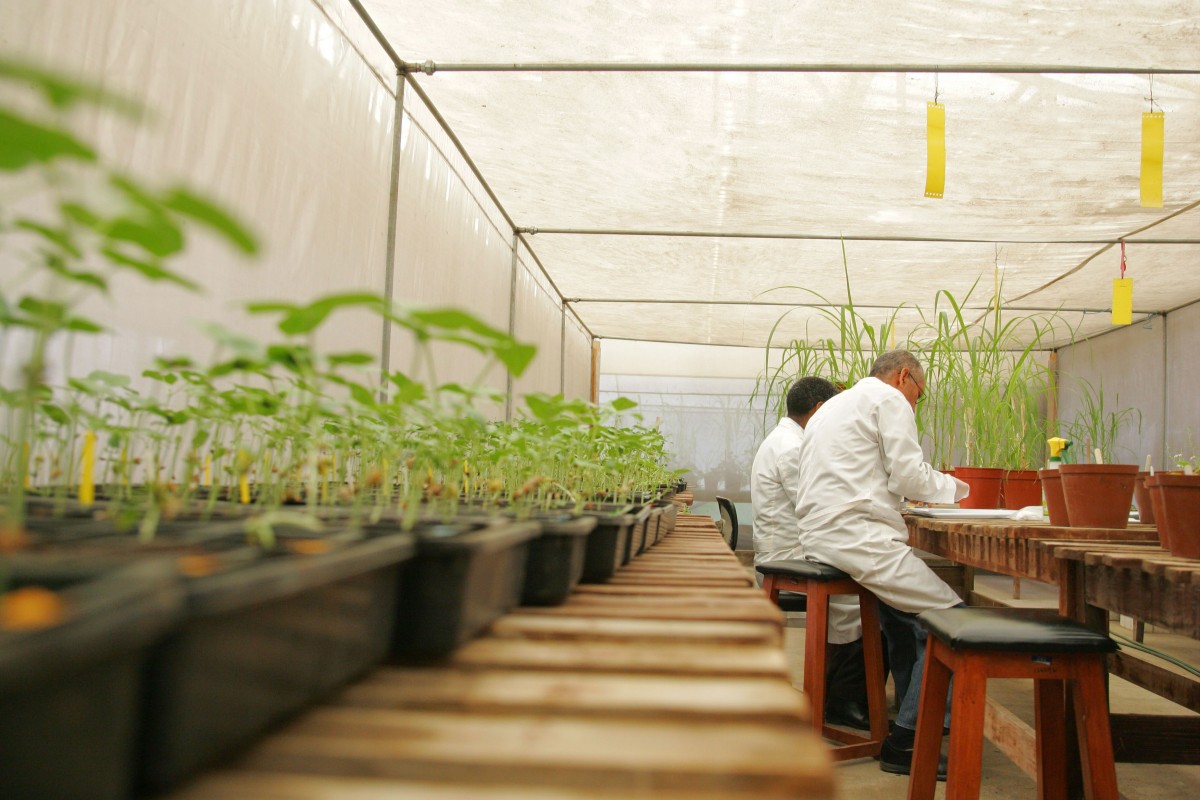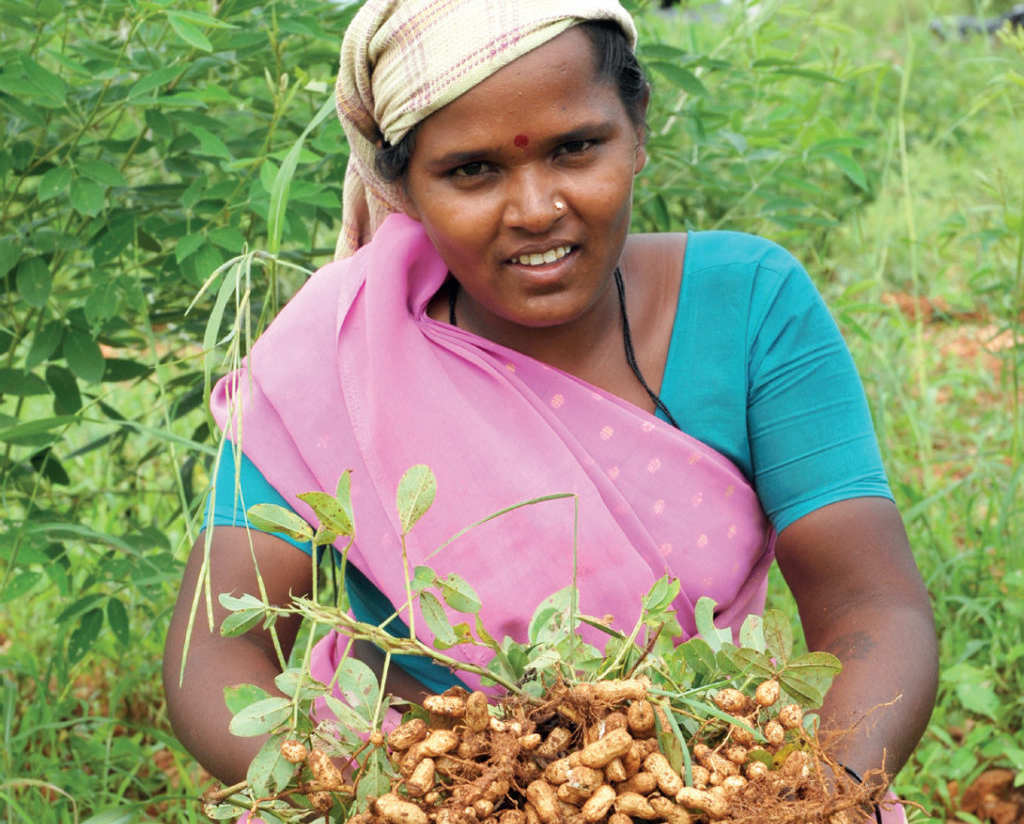
No such thing as waste: full-purpose crops a double boon for people and livestock
The dry, gravelly red-hued soils of drought-prone Anantapur, in the heart of Southern India, might seem an unlikely spot for the largest peanut-growing district in the world. But the profitable, resilient crop, known locally as groundnut, stretches over upwards of 725,000 hectares – more than 70% of the district’s cultivated area.
“Almost every farmer there grows it,” says Janila Pasupuleti, Principal Groundnut Breeder at ICRISAT; “and almost every available field is covered in groundnut.”
And in Anantapur, it’s not just the knobby underground pods that matter to farmers. Groundnut stems and leaves (termed ‘haulms’) are a critical fodder source for livestock, especially in dry periods when there’s little or no grass for the animals to eat.
In the early 2000s, scientists at the International Crops Research Institute for the Semi-Arid Tropics (ICRISAT) introduced a new variety, ‘ICGV 91114’, to the area. The cultivar was specifically developed by scientists for grain yield and quality, drought resistance, early maturity – and more easily digestible, palatable haulms for livestock. Research by ICRISAT and the International Livestock Research Institute (ILRI) has confirmed that one of the critical drivers for adoption is its contribution to milk production – on-farm trials showed cattle fed on ICGV91114 fodder gave an average of 11% more milk per day than those fed fodder from local cultivars.
India is the world’s leading producer and consumer of dairy products, but its high population density means grazing land is increasingly scarce. As such, biomass from grain crops – stalks, leaves and other residues – is a critical resource, which makes up an estimated 70% of all livestock feed annually across the country.
 From India to Ethiopia, crop residues - the 'leftovers' after crops have been harvested - have long been valued by farmers as feed for their livestock. (Left) Photo S. Macmillan/ILRI (right) A. Habtamu/ILRI
From India to Ethiopia, crop residues - the 'leftovers' after crops have been harvested - have long been valued by farmers as feed for their livestock. (Left) Photo S. Macmillan/ILRI (right) A. Habtamu/ILRI
These ‘leftovers’ are the most abundant kind of renewable biomass on earth, and require no extra land, water or other inputs than those used to cultivate the crops themselves. Although some nutrient loss occurs when residues are taken for use as fodder (rather than being recycled into the soil), the value gained from increased livestock production can help farmers pay for dung and fertilizer to keep soil fertility up. What's more, when residues are not used for fodder, it's common practice among many farmers, particularly in irrigated areas, to simply burn them to get them 'out of the way'.
Because most breeding programs to date have focussed solely on grain quality and quantity, cereal crop residues are traditionally low in nutrients. But scientists at ICRISAT and ILRI, in collaboration with plant breeders, have shown that with the right cultivars – and a conducive policy environment – farmers across the developing world can make much more out of their harvest ‘leftovers’.
A win-win for people and livestock?
The majority of livestock across the tropics are undernourished, and that makes them decidedly underproductive. A recent study showed that in the top 10% of a sample of dairy households in India, independently of dairy genetics, milk yields were around 2200 kg/head/year, while in the remaining 90% of households they were less than 400 kg/head/year. As demand grows across the globe for meat and dairy products, this productivity gap means the 600-million-odd low-income farmers and herders in the developing world are missing out on potential profits and livelihoods.
That’s why, in the 1990s, ILRI scientists Ercole Zerbini and, from 2000 onwards, Michael Blűmmel and his team began exploring whether they could work with crop scientists to develop cultivars that would improve the quality and quantity of fodder byproducts, without trade-offs for the grain itself.
“Traditionally, there's been a bit of a conflict, because people have always assumed that if you select for fodder traits, you might compromise the grain yield or the grain quality to satisfy people’s food needs,” says Blümmel.
But the scientists soon found that it was possible to improve the grain, crop residue yield and fodder quality simultaneously – and that such cultivars were popular with smallholders. “Farmers have seen for themselves that the yields of their animals go much higher when they use these varieties,” says Pasupuleti; and as such, they’re often willing to pay more for ‘full-purpose’ cultivars that produce better fodder.
“The animal [fodder] traits are becoming co-products rather than byproducts, and a part of the value proposition of the trait,” says Blümmel; he estimates that in rainfed areas this usually represents around 30 to 50% of the overall crop value.
“We've had a couple of sorghum varieties that have failed on the market, not because the grain yield wasn't good enough, but it was the fodder traits which weren't good enough for the farmers to benefit financially,” he says.
The research also showed that in some situations – such as during droughts – the fodder component “actually becomes even more important than the grain itself,” says Pasupuleti, as it can be critical for keeping animals alive over these periods.
 Crop breeders are focusing on selecting cultivars for release to farmers that fulfill ‘full-purpose’ criteria: resilient, locally-adapted varieties that produce high food yield, high fodder yield and good straw quality. Photo S. Mann/ILRI
Crop breeders are focusing on selecting cultivars for release to farmers that fulfill ‘full-purpose’ criteria: resilient, locally-adapted varieties that produce high food yield, high fodder yield and good straw quality. Photo S. Mann/ILRI
In the Beed district of Maharashtra State – also in Southern India – full-purpose sorghum crops are becoming increasingly popular among farmers, as the unusually-long droughts of recent years highlight the need for affordable animal feed and multiple income streams.
“Farmers have been paying a lot of money for their fodder,” says Vasant Prabhurao Suryavanshi, an extension agronomist for the Regional Agricultural Extension Education Centre in Ambajogai. “They’re realising that when there are ups and downs in the climate, the animal feed is very valuable, so they’re finding that the [full-purpose] sorghum is the best option for them.”
Policy progress: making fodder traits part of the package
To scale up the use of full-purpose crops, conducive policy is an important piece of the puzzle. In this respect, India’s sorghum and millet sectors seem to be leading the way: under national guidelines released by the All India Coordinated Research Projects initiative, only full-purpose cultivars of these crops are allowed to be released, and good fodder yield (called ‘stovers’ for millet and sorghum) is considered a must-have trait.
“So this is very good,” says Pasupuleti, “because it means if a variety has an excellent grain yield but it does not have a good stover yield, that's not the one they're going to release for commercial cultivation.” Pasupuleti’s only qualm with the guidelines as they stand is that they designate fodder quantity but not quality, which means that some nutrient-dense cultivars may be getting overlooked.
“I think India needs to specify quality in the guidelines,” she says; “if it's not specifically in the criteria, then the trait gets lost.”
The full-purpose crop concept is also being adopted by maize breeders in the country. In Karnataka state, for instance, smallholders are benefiting from new drought- and heat-tolerant hybrids developed as part of the Heat Tolerant Maize for Asia project, which also have a ‘stay-green’ trait that means the plants’ leaves and stems can be fed to livestock after the cobs have been harvested. However, the primary foci for this crop so far are food yield and stress resistance, and fodder traits are still viewed as something of a ‘bonus’ by breeders, rather than must-have attributes.
As the concept gains traction, Blümmel says it’s important to keep making sure that grain quality and quantity is unaffected by fodder improvements. Because full-purpose crops have higher nutritional value, they often have less lignin (the organic polymer that sits in the cell walls of many plants, making them rigid and woody), so there are some concerns about rain or heavy winds knocking crops down more frequently and reducing grain yields as a result.
“So we're very keen to make sure that whatever we do, it doesn't compromise the yield of the grain,” he says; “it's all about working out how far you can push it without having that negative impact.”
 The groundnut ICGV 91114 developed by ICRISAT in India is a fast-growing higher yielding cultivar for both food and fodder. Photo L.V. Sagar/ICRISAT
The groundnut ICGV 91114 developed by ICRISAT in India is a fast-growing higher yielding cultivar for both food and fodder. Photo L.V. Sagar/ICRISAT
Looking ahead
Blümmel and his colleagues are also exploring another option for getting the most out of crop residues: using cellulosic biofuel technology (the processes initially developed to create bioethanol from ligno cellulosic plant biomass) to make fodder nutrients more bioavailable for livestock. Around four billion tons of crop residues are produced across the world annually.
“You can modify or select for improved nutrition,” he says, “and then combine that with a chemical or physical treatment, and effectively turn those residues into concentrate feeds which are of much higher nutritional value.”
Pasupuleti would like to see fodder quantity and quality designated as ‘must-have’ traits for all grain cultivars released in India within the next five years. Making that change will require some political advocacy: “we need to work with people at the helm of affairs, who are making policies and influencing them,” she says. “Having their investment is really important.”
Once those guidelines are in place, “we can use the example of India to help other countries to follow suit,” says Pasulupeti. “As a country we have great pride in developing some of those traits, and I think that having concrete examples like this – in a developing country – will make it easier to move ahead in other places.”
On that note, ILRI is working hard to expand its nutrition analysis platform, “so that people can understand and then can accurately, quickly and cost-effectively measure these traits,” says Blümmel.
The organisation already has major centres in India and Ethiopia; it has just set up capabilities in Burkina Faso and Nigeria; and it’s working on establishing capabilities in Kenya, too. Once that’s done, breeding the best full-purpose cultivars for people and livestock will hopefully become “a whole lot more routine,” says Blümmel.





